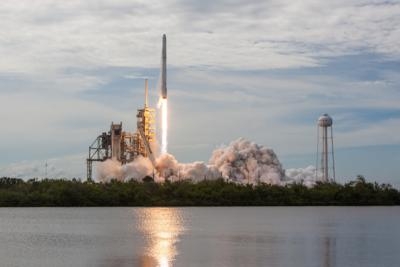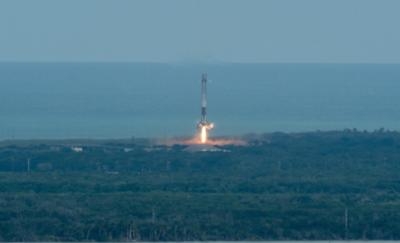Launched Saturday Aboard A Previously-Flown Falcon 9 Rocket
A refurbished Dragon unmanned cargo vessel launched Saturday atop a space-proven Falcon 9 booster reached the International Space Station Monday morning, and was successfully grappled and docked to the station.

The spacecraft carried major experiments that will look into the human body and out into the galaxy. The Dragon lifted off from Launch Complex 39A at NASA's Kennedy Space Center in Florida. The payload included about 6,000 pounds of research equipment, cargo and supplies.
Research materials flying inside the Dragon's pressurized area include an experiment studying fruit flies to better understand the effects on the heart of prolonged exposure to microgravity. Because they're small, age rapidly, and have a well-known genetic make-up, they are good models for heart function studies. This experiment could significantly advance understanding of how spaceflight affects the cardiovascular system and could aid in the development of countermeasures to help astronauts.
The Systemic Therapy of NELL-1 for osteoporosis investigation tests a new drug that can rebuild bone and block further bone loss, improving crew health. When people and animals spend extended periods of time in space, they experience bone density loss, or osteoporosis. In-flight countermeasures, such as exercise, prevent it from getting worse, but there isn't a therapy on Earth or in space that can restore bone. The results from this ISS National Laboratory-sponsored investigation build on previous research also supported by the National Institutes for Health and could lead to new drugs for treating bone density loss in millions of people on Earth.
Three payloads inside Dragon's unpressurized area will demonstrate new solar panel technologies, study the physics of neutron stars, and host an array of Earth-viewing instruments.
Spaceflight Now reports that the booster was recovered on land back at the Kennedy Space Center in Florida. The company has now recovered 11 boosters overall in 16 attempts. This was the fifth recovery at the landing facility at the space center. It was also the 100th launch from historic launch complex 39A.

This mission is SpaceX's eleventh cargo flight to the station under NASA's Commercial Resupply Services contract. Dragon's cargo will support dozens of the more than 250 science and research investigations during the station's Expeditions 52 and 53.
Notably, the spacecraft was carrying an experiment built by students at the Singapore American School (SAS) -- the first ever experiment to be sent to space by high schoolers in Singapore. The MicroLab -- a container that encases a scientific experiment -- is scheduled to arrive on the International Space Station (ISS) after two days of spaceflight. This is the first time a Singaporean experiment will be installed by astronauts on board the ISS.
For over a year, student leader Sunita Srivatsan and her team of five -- Jaclyn Chan, Keshav Jagannath, Annie Kim, Madeline Smith, and Devansh Tandon, guided by SAS Robotics coaches Meredith White and Bart Millar -- have been meticulously planning, collaborating, and researching to set up an experiment to study the effects of microgravity on mutations in bacteria.
The Dragon spacecraft is scheduled to depart the space station in early July, returning with more than 3,400 pounds of science, hardware and crew supplies.
For more than 16 years, humans have lived and worked continuously aboard the International Space Station, advancing scientific knowledge and demonstrating new technologies, making research breakthroughs not possible on Earth that will enable long-duration human and robotic exploration into deep space. A global endeavor, more than 200 people from 18 countries have visited the unique microgravity laboratory that has hosted more than 1,900 research investigations from researchers in more than 95 countries.
(Images provided by SpaceX and NASA. Source: NASA news release and as cited)
 Aero-News: Quote of the Day (12.09.25)
Aero-News: Quote of the Day (12.09.25) ANN's Daily Aero-Term (12.09.25): High Speed Taxiway
ANN's Daily Aero-Term (12.09.25): High Speed Taxiway ANN's Daily Aero-Linx (12.09.25)
ANN's Daily Aero-Linx (12.09.25) NTSB Final Report: Diamond Aircraft Ind Inc DA20C1 (A1); Robinson Helicopter R44
NTSB Final Report: Diamond Aircraft Ind Inc DA20C1 (A1); Robinson Helicopter R44 ANN FAQ: Q&A 101
ANN FAQ: Q&A 101




